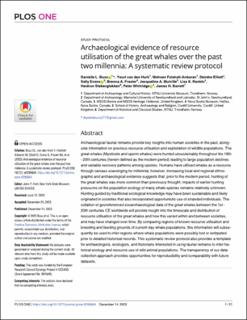| dc.contributor.author | Buss, Danielle Lia | |
| dc.contributor.author | van den Hurk, Youri | |
| dc.contributor.author | Falahati-Anbaran, Mohsen | |
| dc.contributor.author | Elliott, Deirdre | |
| dc.contributor.author | Evans, Sally | |
| dc.contributor.author | Frasier, Brenna A. | |
| dc.contributor.author | Mulville, Jacqueline A. | |
| dc.contributor.author | Rankin, Lisa K. | |
| dc.contributor.author | Stebergløkken, Heidrun Marie Voldheim | |
| dc.contributor.author | Whitridge, Peter | |
| dc.contributor.author | Barrett, James Harold | |
| dc.date.accessioned | 2024-01-29T08:38:52Z | |
| dc.date.available | 2024-01-29T08:38:52Z | |
| dc.date.created | 2024-01-05T08:52:51Z | |
| dc.date.issued | 2023 | |
| dc.identifier.citation | PLOS ONE. 2023, 18 (12), . | en_US |
| dc.identifier.issn | 1932-6203 | |
| dc.identifier.uri | https://hdl.handle.net/11250/3114200 | |
| dc.description.abstract | Archaeological faunal remains provide key insights into human societies in the past, alongside information on previous resource utilisation and exploitation of wildlife populations. The great whales (Mysticete and sperm whales) were hunted unsustainably throughout the 16th - 20th centuries (herein defined as the modern period) leading to large population declines and variable recovery patterns among species. Humans have utilised whales as a resource through carcass scavenging for millennia; however, increasing local and regional ethnographic and archaeological evidence suggests that, prior to the modern period, hunting of the great whales was more common than previously thought; impacts of earlier hunting pressures on the population ecology of many whale species remains relatively unknown. Hunting guided by traditional ecological knowledge may have been sustainable and likely originated in societies that also incorporated opportunistic use of stranded individuals. The collation of georeferenced zooarchaeological data of the great whales between the 1st - 20th centuries CE worldwide will provide insight into the timescale and distribution of resource utilisation of the great whales and how this varied within and between societies, and may have changed over time. By comparing regions of known resource utilisation and breeding and feeding grounds of current-day whale populations, this information will subsequently be used to infer regions where whale populations were possibly lost or extirpated prior to detailed historical records. This systematic review protocol also provides a template for archaeologists, ecologists, and historians interested in using faunal remains to infer historical ecology and resource use of wild animal populations. The transparency of our data collection approach provides opportunities for reproducibility and comparability with future datasets. | en_US |
| dc.language.iso | eng | en_US |
| dc.publisher | Public Library of Science | en_US |
| dc.rights | Navngivelse 4.0 Internasjonal | * |
| dc.rights.uri | http://creativecommons.org/licenses/by/4.0/deed.no | * |
| dc.title | Archaeological evidence of resource utilisation of the great whales over the past two millennia: A systematic review protocol | en_US |
| dc.title.alternative | Archaeological evidence of resource utilisation of the great whales over the past two millennia: A systematic review protocol | en_US |
| dc.type | Peer reviewed | en_US |
| dc.type | Journal article | en_US |
| dc.description.version | publishedVersion | en_US |
| dc.source.pagenumber | 0 | en_US |
| dc.source.volume | 18 | en_US |
| dc.source.journal | PLOS ONE | en_US |
| dc.source.issue | 12 | en_US |
| dc.identifier.doi | 10.1371/journal.pone.0295604 | |
| dc.identifier.cristin | 2221034 | |
| cristin.ispublished | true | |
| cristin.fulltext | original | |
| cristin.qualitycode | 1 | |

